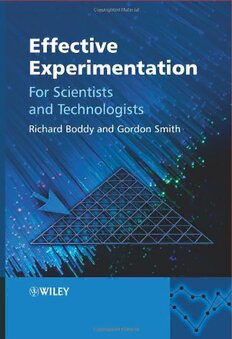Table Of ContentEffective Experimentation
For Scientists and Technologists
Richard Boddy
Gordon Smith
Statistics for Industry, UK
Effective Experimentation
Effective Experimentation
For Scientists and Technologists
Richard Boddy
Gordon Smith
Statistics for Industry, UK
Thiseditionfirstpublished2010
(cid:1)2010,JohnWiley&Sons,Ltd
Registeredoffice
JohnWiley&SonsLtd,TheAtrium,SouthernGate,Chichester,WestSussex,PO198SQ,UnitedKingdom
Fordetailsofourglobaleditorialoffices,forcustomerservicesandforinformationabouthowtoapplyforpermission
to reuse the copyright material in this book please see our website at www.wiley.com.
Therightoftheauthortobeidentifiedastheauthorofthisworkhasbeenassertedinaccordancewiththe
Copyright,DesignsandPatentsAct1988.
Allrightsreserved.Nopartofthispublicationmaybereproduced,storedinaretrievalsystem,ortransmitted,
inanyformorbyanymeans,electronic,mechanical,photocopying,recordingorotherwise,exceptaspermitted
bytheUKCopyright,DesignsandPatentsAct1988,withoutthepriorpermissionofthepublisher.
Wileyalsopublishesitsbooksinavarietyofelectronicformats.Somecontentthatappearsinprintmaynotbe
availableinelectronicbooks.
Designationsusedbycompaniestodistinguishtheirproductsareoftenclaimedastrademarks.Allbrandnames
andproductnamesusedinthisbookaretradenames,servicemarks,trademarksorregisteredtrademarksoftheir
respectiveowners.Thepublisherisnotassociatedwithanyproductorvendormentionedinthisbook.Thispublication
isdesignedtoprovideaccurateandauthoritativeinformationinregardtothesubjectmattercovered.Itissoldonthe
understandingthatthepublisherisnotengagedinrenderingprofessionalservices.Ifprofessionaladviceorother
expertassistanceisrequired,theservicesofacompetentprofessionalshouldbesought.
LibraryofCongressCataloguing-in-PublicationData
Boddy,Richard,1939
Effectiveexperimentation:forscientistsandtechnologists/RichardBoddy,GordonLairdSmith.
p.cm.
Includesindex.
ISBN978-0-470-68460-3(hardback)
1. Science Experiments Statisticalmethods. 2. Technology Experiments Statisticalmethods.
I. Smith,Gordon(GordonLaird) II. Title.
Q182.3.B6352010
507.2’7 dc22
2010010298
AcataloguerecordforthisbookisavailablefromtheBritishLibrary.
ISBN:978-0-470-68460-3
Setin10/12pt,TimesRomanbyThomsonDigital,Noida,India.
PrintedandboundintheUnitedKingdombyAntonyRoweLtd,Chippenham,Wiltshire.
Contents
Preface xi
1 Why Bother toDesignan Experiment? 1
1.1 Indroduction 1
1.2 Examplesand Benefits 1
1.2.1 Develop aBetter Product 1
1.2.2 Which Antiperspirant isBest? 2
1.2.3 AComplexProject 2
1.3 Good Design andGood Analysis 3
2 AChange for the Better SignificanceTesting 5
2.1 Introduction 5
2.2 Towardsa Darker Stout 5
2.3 SummaryStatistics 6
2.4 The Normal Distribution 7
2.5 HowAccurate isMy Mean? 8
2.6 Isthe NewAdditivean Improvement? 9
2.7 HowManyTrials are Needed for anExperiment? 11
2.8 Were the Aims of the Investigation Achieved? 12
2.9 Problems 13
3 Improving EffectivenessUsing aPairedDesign 15
3.1 Introduction 15
3.2 AnExample:Who Wears the Trousers? 15
3.3 HowDoWe Rate the Wear? 16
3.4 HowOften Do You Carry Out anAssessment? 16
3.5 Choosingthe Participants 16
3.6 Controlling the Participants 16
3.7 The Paired Design 17
3.8 Wasthe Experiment Successful? 19
3.9 Problems 19
4 ASimple butEffectiveDesign for TwoVariables 21
4.1 Introduction 21
4.2 AnInvestigation 21
4.3 Limitations ofa One-Variable-at-a-Time Experiment 22
4.4 AFactorial Experiment 25
4.5 ConfidenceIntervals for Effect Estimates 29
4.6 What ConditionsShould be Recommended? 31
4.7 Were the Aims of the Investigation Achieved? 31
4.8 Problems 32
vi CONTENTS
5 Investigating 3 and4 Variables in anExperiment 35
5.1 Introduction 35
5.2 AnExperiment with Three Variables 35
5.3 The Design MatrixMethod 37
5.4 ComputationofPredicted Values 39
5.5 ComputationofConfidence Interval 40
5.6 95%Confidence Interval for an Effect 41
5.7 95%Confidence Interval for aPredicted Value 42
5.8 Sequencingofthe Trials 42
5.9 Were the Aims of the Experiment Achieved? 42
5.10 AFour-VariableExperiment 43
5.11 Half-Normal Plots 44
5.12 Were the Aims of the Experiment Achieved? 46
5.13 Problems 46
6 More for EvenLess: Using a Fractionof aFullDesign 51
6.1 Introduction 51
6.2 Obtaining Half-Fractional Designs 52
6.2.1 With DefiningContrast ABC 55
6.2.2 With DefiningContrast AC 55
6.3 Design of ½(24)Experiment 56
6.4 Analysinga Fractional Experiment 57
6.5 Summary 59
6.6 Did WheelwrightAchievethe Aims of HisExperiment? 59
6.7 When and Where toChoosea Fractional Design 60
6.7.1 Three Variables 60
6.7.2 Four Variables 60
6.7.3 FiveVariables orMore 61
6.8 Problems 63
7 SaturatedDesigns 65
7.1 Introduction 65
7.2 Towards a Better Oil? 65
7.3 The Experiment 66
7.4 AnAlternativeProcedure for Estimating the Residual SD 69
7.5 Did Doug Achievethe Aims of HisExperiment? 70
7.6 HowRugged isMy Method? 70
7.7 Analysisofthe Design 70
7.8 Conclusions fromthe Experiment 72
7.9 Did Serena AchieveHer Aims? 73
7.10 Which Order Should IUse for the Trials? 73
7.11 HowtoObtainthe Designs 73
7.12 Other Uses ofSaturated Designs 74
7.13 Problems 75
8 Regression Analysis 77
8.1 Introduction 77
8.2 Example: Keeping Quality ofSprouts 77
CONTENTS vii
8.3 HowGood a Fit Has the Line to the Data? 78
8.4 Residuals 79
8.5 PercentageFit 81
8.6 Correlation Coefficient 81
8.7 PercentageFit AnEasierMethod 82
8.8 IsThere a Significant Relationship between the Variables? 82
8.9 ConfidenceIntervals for the Regression Statistics 82
8.10 Assumptions 83
8.11 Problem 84
9 Multiple Regression:TheFirst Essentials 87
9.1 Introduction 87
9.2 AnExperiment toImprovethe Yield 87
9.3 Building aRegression Model 89
9.4 Selecting the First IndependentVariable 89
9.5 Relationship between Yieldand Weight 91
9.6 Model Building 93
9.7 Selecting the Second Independent Variable 93
9.8 AnAlternativeModel 96
9.9 Limitations tothe Analysis 97
9.10 Wasthe Experiment Successful? 98
9.11 Problems 99
10 Designsto Generate ResponseSurfaces 101
10.1 Introduction 101
10.2 AnExample:Easing the Digestion 101
10.3 AnalysisofCrushingStrength 104
10.4 AnalysisofDissolutionTime 107
10.5 HowManyLevelsof aVariable Should We Use ina Design? 109
10.6 Wasthe Experiment Successful? 110
10.7 Problem 110
11 Outliersand Influential Observations 113
11.1 Introduction 113
11.2 AnOutlier in One Variable 113
11.3 Other Outlier Tests 115
11.4 Outliers inRegression 116
11.5 Influential Observations 117
11.6 Outliers and InfluenceinMultiple Regression 118
11.7 What toDoAfterDetection? 120
12 Central Composite Designs 121
12.1 Introduction 121
12.2 AnExample: Design the Crunchiness 121
12.3 Estimating the Variability 123
12.4 Estimating the Effects 123
12.5 Using Multiple Regression 125

